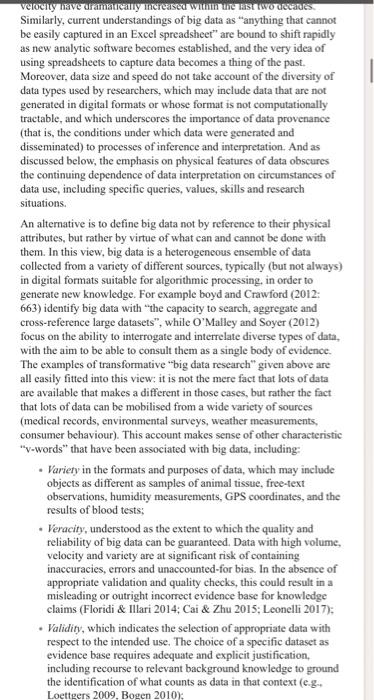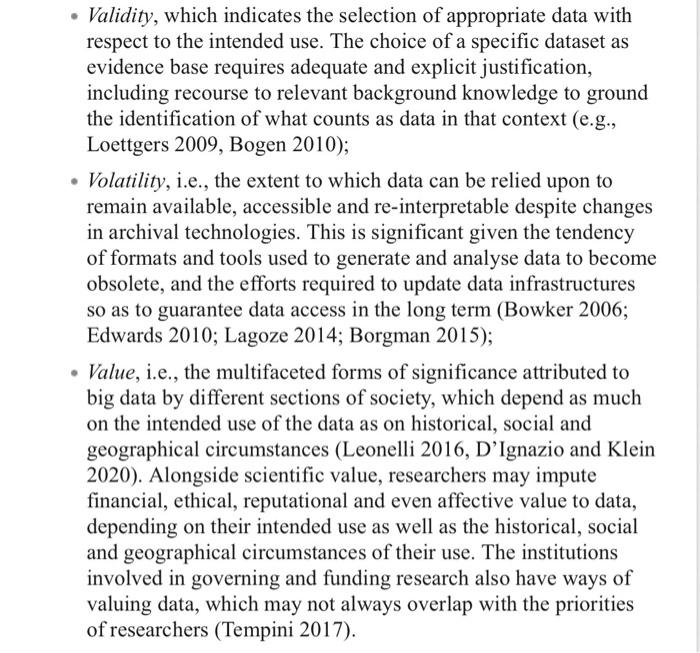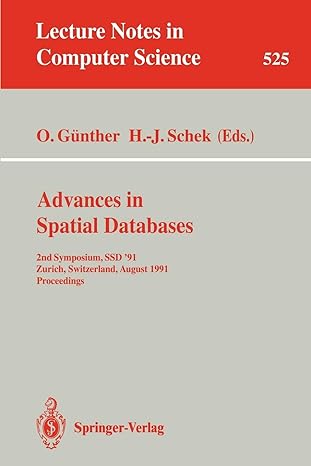form a argument reconstruction

1. What Are Big Data? We are witnessing a progressive "datafication of social life. Human activities and interactions with the environment are being monitored and recorded with increasing effectiveness, generating an enormous digital footprint. The resulting "big data" are a treasure trove for research, with ever more sophisticated computational tools being developed to extract knowledge from such data. One example is the use of various different types of data acquired from cancer patients, including genomic sequences, physiological measurements and individual responses to treatment, to improve diagnosis and treatment. Another example is the integration of data on traffic flow, environmental and geographical conditions, and human behaviour to produce safety measures for driverless vehicles, so that when confronted with unforeseen events (such as a child suddenly darting into the street on a very cold day), the data can be promptly analysed to identify and generate an appropriate response (the car swerving enough to avoid the child while also minimising the risk of skidding on ice and damaging to other vehicles). Yet another instance is the understanding of the nutritional status and needs of a particular population that can be extracted from combining data on food consumption generated by commercial services (e.g., supermarkets, social media and restaurants) with data coming from public health and social services, such as blood test results and hospital intakes linked to malnutrition. In each of these cases, the availability of data and related analytic tools is creating novel opportunities for research and for the development of new forms of inquiry, which are widely perceived as having a transformative effect on science as a whole. A useful starting point in reflecting on the significance of such cases for a philosophical understanding of research is to consider what the term "big data" actually refers to within contemporary scientific discourse. There are multiple ways to define big data (Kitchin 2014, Kitchin & McArdle 2016). Perhaps the most straightforward characterisation is as large datasets that are produced in a digital form and can be analysed through computational tools. Hence the two features most commonly associated with Big Data are volume and velocity. Volume refers to the size of the files used to archive and spread data. Velocity refers to the pressing speed with which data is generated and processed. The body of digital data created by research is growing at breakneck pace and in ways that are arguably impossible for the human cognitive system to grasp and thus require some form of automated analysis. Volume and velocity are also, however, the most disputed features of big data. What may be perceived as "large volume" or "high velocity depends on rapidly evolving technologies to generate, store, disseminate and visualise the data. This is exemplified by the high- throughput production, storage and dissemination of genomic sequencing and gene expression data, where both data volume and Velochy sve uramaccally creased wim Team Weaves Similarly, current understandings of big data as "anything that cannot be easily captured in an Excel spreadsheet" are bound to shift rapidly as new analytic software becomes established, and the very idea of using spreadsheets to capture data becomes a thing of the past. Moreover, data size and speed do not take account of the diversity of data types used by researchers, which may include data that are not generated in digital formats or whose format is not computationally tractable, and which underscores the importance of data provenance (that is, the conditions under which data were generated and disseminated) to processes of inference and interpretation. And as discussed below, the emphasis on physical features of data obscures the continuing dependence of data interpretation on circumstances of data use, including specific queries, values, skills and research situations An alternative is to define big data not by reference to their physical attributes, but rather by virtue of what can and cannot be done with them. In this view, big data is a heterogeneous ensemble of data collected from a variety of different sources, typically (but not always) in digital formats suitable for algorithmic processing, in order to generate new knowledge. For example boyd and Crawford (2012: 663) identify big data with the capacity to search, aggregate and cross-reference large datasets", while O'Malley and Soyer (2012) focus on the ability to interrogate and interrelate diverse types of data, with the aim to be able to consult them as a single body of evidence. The examples of transformative "big data research" given above are all casily fitted into this view: it is not the mere fact that lots of data are available that makes a different in those cases, but rather the fact that lots of data can be mobilised from a wide variety of sources (medical records, environmental surveys, weather measurements, consumer behaviour). This account makes sense of other characteristic "v-words" that have been associated with big data, including: Variety in the formats and purposes of data, which may include objects as different as samples of animal tissue, free-text observations, humidity measurements, GPS coordinates, and the results of blood tests; Veracity, understood as the extent to which the quality and reliability of big data can be guaranteed. Data with high volume, velocity and variety are at significant risk of containing inaccuracies, errors and unaccounted-for bias. In the absence of appropriate validation and quality checks, this could result in a misleading or outright incorrect evidence base for knowledge claims (Floridi & Illari 2014; Cai & Zhu 2015; Leonelli 2017): Validity, which indicates the selection of appropriate data with respect to the intended use. The choice of a specific dataset as evidence base requires adequate and explicit justification, including recourse to relevant background knowledge to ground the identification of what counts as data in that context (e.g., Loettgers 2009. Bogen 2010): Validity, which indicates the selection of appropriate data with respect to the intended use. The choice of a specific dataset as evidence base requires adequate and explicit justification, including recourse to relevant background knowledge to ground the identification of what counts as data in that context (e.g., Loettgers 2009, Bogen 2010); Volatility, i.e., the extent to which data can be relied upon to remain available, accessible and re-interpretable despite changes in archival technologies. This is significant given the tendency of formats and tools used to generate and analyse data to become obsolete, and the efforts required to update data infrastructures so as to guarantee data access in the long term (Bowker 2006; Edwards 2010; Lagoze 2014; Borgman 2015); Value, i.e., the multifaceted forms of significance attributed to big data by different sections of society, which depend as much on the intended use of the data as on historical, social and geographical circumstances (Leonelli 2016, D'Ignazio and Klein 2020). Alongside scientific value, researchers may impute financial, ethical, reputational and even affective value to data, depending on their intended use as well as the historical, social and geographical circumstances of their use. The institutions involved in governing and funding research also have ways of valuing data, which may not always overlap with the priorities of researchers (Tempini 2017)










